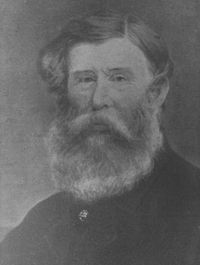
Frederick Arthur Verner
Encyclopedia

Canada
Canada is a North American country consisting of ten provinces and three territories. Located in the northern part of the continent, it extends from the Atlantic Ocean in the east to the Pacific Ocean in the west, and northward into the Arctic Ocean...
painter, famous for his landscape and scenery paintings from the Canadian plains in the west.
Verner was born at Sheridan, Ontario
Ontario
Ontario is a province of Canada, located in east-central Canada. It is Canada's most populous province and second largest in total area. It is home to the nation's most populous city, Toronto, and the nation's capital, Ottawa....
, which was then called Hammondsville, in Upper Canada
Upper Canada
The Province of Upper Canada was a political division in British Canada established in 1791 by the British Empire to govern the central third of the lands in British North America and to accommodate Loyalist refugees from the United States of America after the American Revolution...
. Already as a boy, he was fascinated and inspired by the paintings of Paul Kane
Paul Kane
Paul Kane was an Irish-born Canadian painter, famous for his paintings of First Nations peoples in the Canadian West and other Native Americans in the Oregon Country....
and tried to convince this established painter to take him on as a pupil, but was turned away. A few years later, he went to London, where he studied at Hetherleys Academy of Arts from 1856 to 1860, before joining the British army, enlisting in the 3rd West York regiment. He returned to Toronto
Toronto
Toronto is the provincial capital of Ontario and the largest city in Canada. It is located in Southern Ontario on the northwestern shore of Lake Ontario. A relatively modern city, Toronto's history dates back to the late-18th century, when its land was first purchased by the British monarchy from...
in 1862, where he worked first as a photograph colorist and then as a photographer himself. During this time, he became a friend of his long-time idol Paul Kane. Verner's work is, like Kane's, also focused on scenes from the Canadian west and also sometimes based on field sketches, although Verner didn't travel as extensively as Kane had done. Many of his paintings are based on sketches made when he accompagnied Alexander Morris
Alexander Morris
Alexander Morris, PC was a Canadian politician. He served in the cabinet of Prime Minister John A. Macdonald , and was the second Lieutenant Governor of Manitoba...
to the signing of the third Northwest Angle
Northwest Angle
The Northwest Angle, known simply as the Angle by locals, and coextensive with Angle Township, is a part of northern Lake of the Woods County, Minnesota, and is the only place in the United States outside Alaska that is north of the 49th parallel...
Treaty at Lake of the Woods
Lake of the Woods
Lake of the Woods is a lake occupying parts of the Canadian provinces of Ontario and Manitoba and the U.S. state of Minnesota. It separates a small land area of Minnesota from the rest of the United States. The Northwest Angle and the town of Angle Township can only be reached from the rest of...
in 1873. In 1880, Verner moved permanently to London, but continued to visit Canada sporadically to paint, and he had frequent exhibitions of his paintings in Toronto. In 1893, he became a member of the Royal Canadian Academy.
He is the uncle of 'The Professor', Dai Vernon.
Verner's work can be found in the permanent collection of the Tom Thomson Art Gallery, Owen Sound, ON CAN. www.tomthomson.org
Further reading
- Murray, J.: The Last Buffalo: The Story of Frederick Arthur Verner, Painter of the Canadian West, Pagurian Press, Toronto 1984. ISBN 0-88932-130-2.

